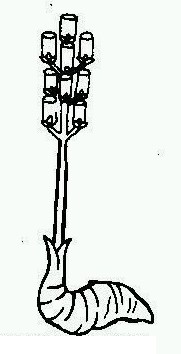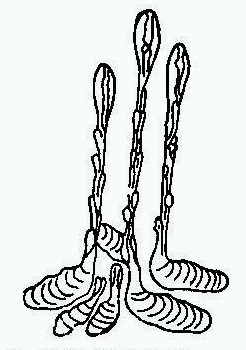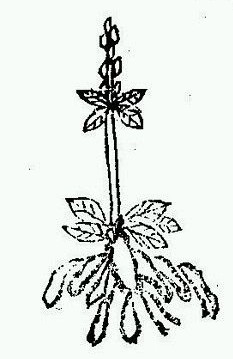| title | Gastrodia Tuber |
| release time | 2006/6/29 |
| source | Jade Knock Studio |
Today, Gastrodia Tuber is used as the dried tuber of the orchid plant Gastrodia elata Bl. This product is mainly produced in Yibin and Leshan of Sichuan, Wanzhou of Chongqing, Zhaotong of Yunnan, Bijie, Anshun, and Zunyi of Guizhou, Luanchuan, Songxian, and Lushi of Henan, Hanzhong of Shaanxi, and also in Hubei, Northeast China, and North China.
Materia medica research suggests that the ancient records of Red Arrow and Gastrodia Tuber are actually the same thing, with the original plant being Gastrodia elata, and there has been little change in the variety from ancient times to the present. The earliest production area of Gastrodia Tuber was around Shaanxi, with Shandong's produce being considered the best during the Song Dynasty, and more recently, the produce from Sichuan, Guizhou, and Yunnan being considered authentic.
bubble_chart Variety Identification
The Bencao Jing lists Red Arrow as a top-grade herb, also known as Limu and Gui Duyou, noting its efficacy as "long-term consumption tonifies qi, strengthens yin, enhances health, lightens the body, and increases longevity." Tao Hong-jing annotated, "This herb is also a type of Zhi, its stem is red like an arrow shaft, leaves grow at its tip, roots resemble human feet, also said to resemble taro, with twelve offspring as guards, it does not move with wind, but sways without wind. Such a description is not commonly seen." According to Tao, this description originates from the Inner Chapters of Baopuzi, Xian Yao, where Ge Hong said, "Among the grass Zhi, there is the Duyao Zhi, which moves without wind, its stem is as thick as a finger, red as cinnabar, with plain leaves resembling amaranth, its root has a large core like a dipper, with twelve fine ones like eggs surrounding the main root in four directions, like the twelve celestial stems, spaced about a zhang apart, all with fine roots like white hair connecting them, growing on high mountains and deep valleys, with no grass around where it grows." The Tujing quotes Baopuzi similarly.
The Wu Pu Materia Medica names it Gui Duyou, stating it is "also known as Divine Grass and Yan Dog. It grows either on Mount Tai or Shaoshi. Its stem is like an arrow, red without leaves, roots like taro seeds. The roots are harvested in March, April, and August, dried in the sun, and used to treat abscesses and swellings."The Xin Xiu states, "This is a type of Zhi, its stem resembles an arrow shaft, red in color, with flowers and leaves at the tip, looking like an arrow with feathers from a distance, the root's skin, flesh, and juice are similar to Asparagus Root, only without a heart vein, five or six inches from the root, there are more than ten offspring guarding it, resembling taro, its fruit resembles Melia Fruit, the core has five or six ridges, the flesh inside is like flour, withering when dried in the sun. The root can be eaten raw when obtained, there is no method for drying and consuming it." The Youyang Zazu, Volume 19, also says, "Heli, its root resembles a taro core, with twelve wandering offspring surrounding it, growing by mutual reinforcement, but the fruits are not connected, linked by qi. Also known as Duyao and Limu, said to be what the locals eat, collectively called Red Arrow."
The Song Dynasty's Kaibao Bencao separately lists Gastrodia Tuber, stating, "Its leaves resemble Peony Root but are smaller, a single stem shoots up straight like an arrow shaft. The tip of the stem bears fruit, resembling caper euphorbia seeds. When the leaves wither, the seeds turn yellow and ripen. Its roots are connected in a chain of ten to twenty, similar to Asparagus Root, shaped like a cucumber, also like a radish, varying in size." The Bencao Tujing's Gastrodia Tuber entry also states, "It sprouts in spring, initially resembling Peony Root, a single stem shoots straight up, two to three feet high, like an arrow shaft, greenish-red in color, hence named Red Arrow Fat. The stem is hollow, with small pointed leaves slightly attached halfway up, the tip forms a spike, flowers and bears seeds the size of beans, the seeds do not fall in summer but penetrate the stem, growing hidden in the soil, its root shaped like a cucumber, connected in a chain of ten to twenty, the larger ones weigh half a catty or five to six taels, its skin is yellow-white, named White Dragon Skin, the flesh is called Gastrodia Tuber."
(1) Regarding the issue of the Kaibao's separate entry for Gastrodia Tuber
The preface of the Kaibao Bencao mentions the reason for separating Chijian and Gastrodia Tuber: "The roots of Gastrodia Tuber resemble those of Chijian, but now they are entirely different. We discard the incorrect and retain the correct, thus establishing a new entry." According to this, it seems that Chijian and Gastrodia Tuber are considered two distinct substances. However, what is puzzling is that, based on the botanical description of Gastrodia Tuber in the Kaibao, it should still refer to Gastrodia elata. In this case, the necessity of separating them into different entries is unclear. Moreover, the recorded efficacy of Gastrodia Tuber in this book significantly differs from that of Chijian in previous materia medica. The Kaibao states: "Gastrodia Tuber, with a pungent and neutral taste, is non-toxic. It primarily treats various wind-dampness bi syndromes, spasms of the limbs, and wind epilepsy with convulsions in children. It benefits the waist and knees, strengthens tendons and muscles, and with prolonged use, it tonifies qi, lightens the body, and promotes longevity." The wind-treating effects mentioned here are not found in the Chijian entries of earlier materia medica.
In Tang dynasty literature, both "Chijian" and "Gastrodia Tuber" were used. However, whenever "Chijian" was mentioned, it was associated with tonic effects, aligning with the Bencao Jing's description of "long-term use tonifies qi, strengthens yin, enhances physical fitness, and promotes longevity." For example, the "Youyang Zazu" records Wu Youxu ascending to immortality after "taking Chijian and Fuling." The "Chunhua Ge Tie" includes a note by Liu Gongquan stating, "If there is Chijian, please send me three to five liang to support my declining health, which would be a great kindness." Bai Juyi's poem "Zhaiju" mentions, "A few spoonfuls of Huangqi porridge, a bowl of Chijian soup." Additionally, the "Zizhi Tongjian" records Princess Taiping conspiring with a palace maid to poison the emperor with Chijian powder. These references to "Chijian" undoubtedly refer to Gastrodia elata.
As for "Gastrodia Tuber," according to the "Bencao Shiyi," it is described as: "Gastrodia Tuber, cold in nature, treats heat toxin abscesses. The stems and leaves are pounded and applied topically, and the seeds are used to make a drink to dispel heat. It grows in wetlands, resembling European Verbena Herb, with purple flowers at each node, and seeds like feather cockscomb." A similar description appears in the "Qianjin Yaofang," in the Gastrodia Tuber Grass Decoction: "Cut five sheng of Gastrodia Tuber grass, boil in one and a half dou of water until reduced to one dou, and use to wash the breasts according to the degree of heat or cold to relieve itching. This grass has leaves like hemp, grows in winter, and blooms in summer with red flowers resembling mouse tails." The "Waitai Miyao" also records this. The "Gastrodia Tuber" or "Gastrodia Tuber grass" mentioned by Chen Cangqi and Sun Simiao likely refers to the same plant, probably a member of the Lamiaceae family, such as motherwort herb, which may correspond to the "Wumu Ma" in the Bielu.
Some texts mention "Gastrodia Tuber" without specifying whether it belongs to the orchid or Lamiaceae family. For example, the "Processing Treatise" states: "When using, avoid Yufeng grass, as it resembles Gastrodia Tuber but differs in leaf and stem. Yufeng grass has white roots, stems, and leaves with green spots." In the Tang dynasty, Chijian was also referred to as "Gastrodia Tuber," as seen in the "Yaoxing Lun": "Chijian fat is also called Gastrodia Tuber, and Dingfeng Grass."
Given the homonymy of "Gastrodia Tuber" in the Tang dynasty, we suspect that the authors of the early Song dynasty "Kaibao" mistakenly conflated the Lamiaceae "Gastrodia Tuber" with the orchid "Chijian." The efficacy section of the "Kaibao" Gastrodia Tuber entry primarily draws from the Lamiaceae "Gastrodia Tuber," while the plant description is based on the orchid "Chijian." Later materia medica, such as the "Bencao Tujing," may have recognized this error, but Su Song still defended it in the Chijian entry, stating: "Although it occasionally appears in the mountains, people cannot recognize its true form, and physicians rarely use it. Thus, no illustrations are provided in regional records. It is a rare and extraordinary plant, not commonly seen, so we only record its description here." Subsequently, Shen Kuo, Kou Zongshi, and Chen Cheng each offered their own explanations, sparking debates over whether Chijian or Gastrodia Tuber should use the shoots or roots. It was not until Li Shizhen that Gastrodia Tuber was reclassified under the Chijian entry.
(2) Regarding the Medicinal Parts of Chijian
As mentioned in the previous article, the "Kaibao" added a separate entry for Gastrodia Tuber apart from the original Chijian entry in the Bencao Jing. From the Bencao Jing to the "Xinxiu," Chijian was always used for its root. Both the Bielu and "Wu Pu" state: "Harvest the root in March, April, and August, and dry it in the sun." The "Xinxiu" says: "If you obtain the root, eat it raw; there is no method for drying and consuming it." Song dynasty physicians, confused by the erroneous division in the "Kaibao," forcibly claimed that the above-ground part of Gastrodia elata was Chijian, while the underground part was Gastrodia Tuber. For example, the Bencao Yanyi states: "Gastrodia Tuber uses the root, while the sprout is Chijian." It also says: "Chijian is the sprout of Gastrodia Tuber, and its treatment differs from Gastrodia Tuber, so later generations separated them into two." Song Shenliao's poem states: "The immortal guest consumes Chijian, its root being Gastrodia Tuber, prolonging life without aging, ascending to mingle with the mist and clouds." This view aligns with the above.
Relatively speaking, Shen Kuo's statements are closer to the truth. In Volume 26 of Mengxi Bitan, it is stated: "Chijian is today's Gastrodia Tuber. Later generations mistakenly listed Gastrodia Tuber as a separate entry, thus referring to Chijian as a different entity. Since such an entity does not exist, they had no choice but to use the seedling of Gastrodia Tuber instead, which is incorrect. The materia medica clearly states that the root should be collected and dried in the shade, so how can the seedling be used? Among the top-grade herbs, apart from the five types of Ganoderma, Chijian is the foremost. It is a superior medicine for immortals to regulate and nourish life. However, people are misled by the theory of Gastrodia Tuber and only use it to treat wind disorders, which is truly regrettable. It is said that its stem resembles an arrow, hence the name Chijian, leading to the suspicion that the stem should be used. This is especially incorrect. For example, in the case of Iris and Achyranthes Root, although their stems and leaves resemble certain things, the roots are used. What is there to doubt?" Gangmu agrees with Shen's view but also states, based on the preface of Bencao Tujing, "If it is Chijian, Benjing only mentions collecting the root, but now both the stem and seedling are taken," thus concluding, "Although Shen's statement is correct, both the root and stem can be used."
(3) Regarding the illustrations of Gastrodia Tuber
The medicinal illustrations in Zhenglei Bencao are generally believed to be derived from Bencao Tujing. Regarding the Chijian entry, Su Song specifically mentioned, "There are no illustrations from the prefectures and counties." According to his statement, the "Yanzhou Chijian" in Figure 1 should not be from the Tujing, but perhaps from older illustrations from previous generations. However, regardless, these medicinal illustrations are quite typical, and their author must have seen Gastrodia elata and did not fabricate them out of thin air.
In contrast to the situation in the Song dynasty, materia medica scholars of the Ming and Qing dynasties probably rarely saw the original plant of Gastrodia Tuber. The illustrations in "Pin Hui Jing Yao" and Bencao Mengquan are all plagiarized from "Zhenglei," so they need not be discussed. Although Li Shi-zhen correctly combined Chijian and Gastrodia Tuber into one entry, the medicinal illustrations he drew are quite absurd (Figure 3). Not only is this the case with the Jinling edition, but this error was also not corrected in the slightly later Jiangxi edition, nor in the Qing dynasty reprint by Zhang Shaotang. Coincidentally, another botanist, Wu Qi-jun, also did not recognize Chijian Gastrodia Tuber. The two illustrations of Chijian in his work "Zhiwu Mingshi Tukao" both imitate "Zhenglei" and are riddled with errors, the reasons for which are unknown.




bubble_chart Historical Changes in Authentic Production Areas
Bencao Jing and Mingyi Bielu record the production areas of Chijian: "Grows in the valleys of Chencang, Yongzhou, and Taishan, Shaoshi." Tao Hong-jing stated, "Chencang belongs to Fufeng County in Yongzhou," which is in the area of present-day Baoji, Shaanxi.
Kaibao Bencao states: "Grows in Yunzhou, Lizhou, Taishan, and Laoshan mountains," and also says, "Nowadays, most use the ones from Yunzhou." The Tujing states: "Now it is also found in the prefectures and counties of Jingdong, Jingxi, Hunan, and Huainan." It also says: "People from Songshan and Hengshan sometimes take the fresh ones and fry them with honey to make a fruit dish, which is highly prized." According to "Zhenglei," the illustrations of "Yanzhou Chijian" and "Shaozhou Gastrodia Tuber" are drawn. Chen Cheng specifically mentioned, "Those from Qi and Yun are considered the best," which might imply that during the Song dynasty, Gastrodia Tuber from Shandong and Hunan was considered authentic.
It may be due to over-harvesting or other reasons that the production areas of Gastrodia Tuber have gradually shifted to the southwest in recent times. Volume 98 of Puji Fang's musk tiger bone powder first mentions "Sichuan Gastrodia Tuber." Chen Renshan's "Materia Medica Production Identification" states: "Those produced in Sichuan, Yunnan, and Hanzhong, Shaanxi are all of good quality." Generally, genuine regional materia medica records often regard Gastrodia Tuber as a genuine regional materia medica of Yunnan and Guizhou.






